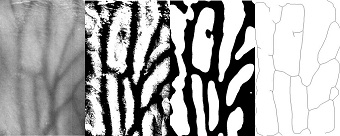Netherlands-based independent R&D lab Holst Center has developed an organic near-infrared large-area image sensor for biometric vein pattern detection to prevent spoofing attempts, writes Phys.org. The Center says it is the first sensor of its type capable of detecting vein patterns from reflected light.
The biometric sensor easily integrates with smartphones and can ensure the security of critical functions in passports and for payment authentication. While fingerprints can be forged, vein patterns spoofing would require capturing an internal image of the hand, making it very difficult to capture an image surreptitiously.
Holst Center’s innovation portfolio includes organic photodiode-based large-area image sensors, visible light prototypes, X-rays and the latest near-infrared (NIR) light that sees through skin.
“Together with a NIR light source, the prototype image sensor opens the door to contactless biometric security through vein pattern detection,” said Daniel Tordera, senior scientist at Holst Center, in a statement. “Our thin-film technologies make for extremely thin and potentially flexible sensors that could be easily integrated into existing displays and things like mobile phones or cash machine screens, eliminating the need for separate ID and credit cards.”
By combining “the organic NIR photodiodes with an oxide thin-film transistor backplane and a focusing lens” researchers “create an NIR image sensor measuring 2.4 x 3.6 cm, large enough to image the palm of a hand or multiple fingers at a distance,” Phys.org explains. The biometric image sensors have 500-ppi resolution for high quality images, while “the sensor achieves external quantum efficiency (EQE) of 40% at 940 nm and a dark current of around 10-6 mA / cm2.”
The research center is continuing its work with NIR sensors. Photodiodes with up to 1100nm efficiency can improve eye tracking, quality control in manufacturing and agriculture, and medical procedures, according to the report.








